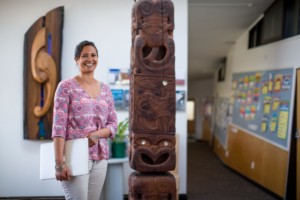
Karen Albert (Student Support Advisor) at Te Whatukura
Numbers at EIT’s Te Whatukura School of Māori Studies in Tūranganui a Kiwa and at EIT’s Ruatoria learning centre have reached the point where the institute is having to beef up resources at both centres.
The number of enrolments for part time studies has increased by nearly a third this year, following a similar increase last year.
As well the numbers studying fulltime are also growing steadily, with a big uptake for the new Level 5 Diploma, which is the first part of the three year degree.
Numbers enrolled for evening classes in Tūranganui a Kiwa were so great this year that the class had to be split, said lecturer Maria Wynyard.
“We used to have one evening class a week on Wednesday and now we have them on Tuesday, Wednesday and Thursday,” she said.
In Ruatoria the newly-introduced classes in te reo Māori were full. The number of enrolments was growing by the week with people traveling from Te Araroa and Ihungia to Tokomaru Bay to take part.
“Our campus carpark has been full because of it – people are wanting to learn their own language. We have got teachers, mothers and hauora workers, and some older people who grew up in the days when speaking te reo was discouraged.
“These people can listen to it competently but speaking it is a different story,” said Maria.
“Our job is to break down those barriers and they are learning very quickly.”
Maria Wynyard is working with te reo tutor Ngaire Keelan to teach the Ruatoria classes, travelling to Gisborne two days a week to teach on the degree programme at Te Whatukura.
EIT was in the process of recruiting another Māori language tutor to join the existing team of seven.
In Gisborne students taking up te reo Māori studies were largely Pakeha, but included all ethnicities, including Asian and South American.
Some were teachers or Government workers who had taken a year’s sabbatical leave to learn the language.
Lecturers were starting to see students progressing their studies to degree level, including one teacher who was combining her studies with fulltime work.
EIT staff are using modern second language learning technologies, modified by the late Ngoi Pewhairangi – a prominent Māori language and culture educator from Tokomaru Bay – for local use.
“We do everything we can to recruit and retain the most qualified and experienced staff,” says Maria.
“They are achieving faster learning te reo Māori students using New Age methods.”
She believes there has been a shift in many workplaces to embrace te reo as part of their culture, encouraging staff to learn conversational Māori and greetings and use them in every day business.
There has been a similar resurgence in Hawke’s Bay, where EIT has been asked to teach te reo Māori courses for the Hastings District Council.
